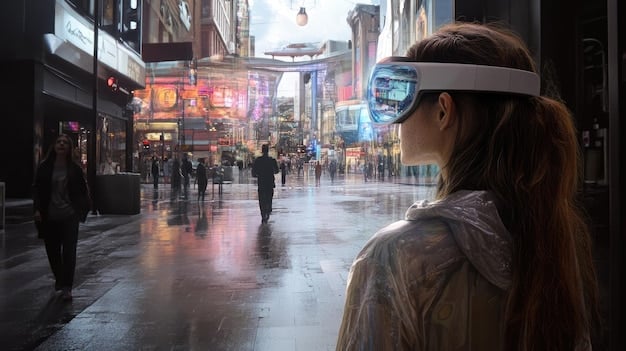Metaverse in 2025: Real Growth or Just Hype? A US Perspective

The Metaverse in 2025 presents a complex landscape; while initial hype has subsided, underlying growth in technology, adoption, and real-world applications suggests that its long-term potential remains significant, especially within the US market.
Is the metaverse destined to revolutionize our lives, or will it fade into obscurity like so many other tech trends? As we look ahead to 2025, the question of whether the Metaverse in 2025: Is the Hype Justified, or Are We Seeing Real Growth? becomes increasingly relevant, particularly within the dynamic US market.
Decoding the Metaverse: Beyond the Buzzwords
The term “metaverse” has become ubiquitous, but its meaning often remains vague. Understanding the metaverse starts with recognizing it as a convergence of technologies rather than a single, monolithic entity. It’s about persistent, shared, 3D virtual worlds that users can access through various devices.
Consider the foundational elements:
- Virtual Reality (VR): Immersive experiences that transport users to simulated environments.
- Augmented Reality (AR): Overlays digital information onto the real world.
- Blockchain Technology: Enables decentralized ownership and digital asset management.
These components, when combined, create the potential for richer, more interactive online experiences. However, widespread adoption hinges on addressing key challenges related to accessibility, usability, and interoperability.

In essence, the metaverse seeks to blur the lines between the physical and digital realms, offering new ways for people to connect, collaborate, and transact. While the initial focus was on gaming and entertainment, the metaverse’s potential extends far beyond these areas, impacting industries ranging from education to healthcare.
State of Metaverse Adoption in the US
The US market stands out as a key battleground for metaverse adoption given its advanced technological infrastructure, large consumer base, and a culture of innovation. Examining current trends reveals a mixed picture of progress and challenges.
Several factors influence the pace of adoption:
- Technology Readiness: The availability of affordable and high-performance VR/AR devices.
- Consumer Awareness: The level of understanding and interest in metaverse experiences.
- Business Investment: The willingness of companies to develop and deploy metaverse applications.
While early adopters have embraced the metaverse for gaming, social interaction, and virtual events, mainstream adoption remains limited. Concerns about cost, complexity, and data privacy continue to hinder broader acceptance.
Major tech companies are investing heavily in metaverse technologies, signaling a long-term commitment to the space. However, the success of these investments will depend on creating compelling user experiences and addressing the practical concerns of potential users.
Key Technologies Driving Metaverse Growth
Several technological advancements are paving the way for a more immersive and accessible metaverse experience. Improvements in hardware, software, and networking are crucial for overcoming current limitations and unlocking the full potential of the metaverse.
Enhanced VR/AR Hardware
Advancements in display technology, processing power, and battery life are making VR/AR headsets more comfortable, affordable, and functional. This, in turn, encourages wider adoption among consumers and businesses.
5G and Edge Computing
The rollout of 5G networks and the expansion of edge computing infrastructure are enabling faster data transfer rates and lower latency, critical for delivering seamless metaverse experiences. These technologies support real-time interactions and high-fidelity graphics.

Blockchain and NFTs
Blockchain technology and NFTs (Non-Fungible Tokens) are enabling decentralized ownership, digital asset management, and new economic models within the metaverse. Users can buy, sell, and trade virtual goods and experiences using cryptocurrencies.
These technologies collectively contribute to a more robust, interactive, and economically viable metaverse ecosystem. As these technologies continue to mature, they will play a key role in shaping the future of the metaverse.
Challenges to Overcome for Metaverse Success
Despite the potential of the metaverse, several significant challenges must be addressed to achieve mainstream adoption and realize its long-term vision. These challenges span technical, social, and ethical dimensions.
The main challenges include:
- Accessibility and Affordability: Ensuring that metaverse technologies are accessible to a wide range of users, regardless of income or technical expertise.
- Interoperability: Enabling seamless interaction between different metaverse platforms and applications.
- Data Privacy and Security: Protecting user data and ensuring secure transactions within the metaverse.
- Content Moderation: Establishing effective mechanisms for moderating content and preventing harassment and abuse.
Addressing these challenges requires collaboration among technology companies, policymakers, and researchers. A proactive approach to addressing these issues is essential for building a safe, inclusive, and productive metaverse experience.
Potential Applications and Use Cases in 2025
By 2025, the metaverse is likely to have expanded beyond its initial focus on gaming and entertainment, finding application in a diverse range of industries and use cases. These applications will offer new opportunities for businesses and consumers alike.
Remote Collaboration and Training
The metaverse can enable more immersive and engaging remote collaboration experiences, allowing teams to work together in shared virtual workspaces. It can also be used for training simulations in fields such as healthcare, manufacturing, and emergency response.
E-commerce and Retail
The metaverse can transform the e-commerce experience by allowing customers to virtually try on clothes, explore products in 3D, and interact with brands in new ways. This can lead to increased sales and improved customer satisfaction.
Education and Learning
The metaverse offers immersive learning environments that can enhance student engagement and understanding. Virtual field trips, interactive simulations, and personalized learning experiences can make education more effective and enjoyable.
Healthcare and Therapy
The metaverse can be used for therapeutic interventions, such as virtual reality therapy for anxiety disorders and pain management. It can also enable remote patient monitoring and telehealth consultations.
These are just a few examples of the many potential applications of the metaverse. As the technology matures and becomes more accessible, we can expect to see even more innovative use cases emerge.
Future Outlook: Is the Metaverse Here to Stay?
Looking ahead to 2025 and beyond, the long-term prospects for the metaverse remain promising, although the path to widespread adoption may be uneven. It relies upon continued tech innovation and smart investment in the US and globally.
Several factors suggest that the metaverse is here to stay:
- Continued Investment: Major technology companies are continuing to invest heavily in metaverse technologies, signaling a long-term commitment to the space.
- Growing User Base: The number of users engaging with metaverse experiences is steadily increasing, albeit at a slower pace than initially anticipated.
- Technological Advancements: Ongoing advancements in VR/AR hardware, 5G networks, and blockchain technology are improving the performance and accessibility of the metaverse.
While the initial hype surrounding the metaverse has subsided, the underlying growth in technology, adoption, and real-world applications suggests that its long-term potential remains significant. The metaverse is likely to evolve and adapt over time, becoming an integral part of our digital lives.
| Key Point | Brief Description |
|---|---|
| 🚀 Tech Convergence | Metaverse is a fusion of VR, AR, and blockchain, enhancing digital interaction. |
| 📱 US Adoption | US leads in metaverse tech but faces adoption hurdles like cost and privacy. |
| 🔑 Future Uses | Beyond gaming, metaverse enables remote work, e-commerce, education, and healthcare. |
| 🤔 Long-Term Stay | Despite hype decline, ongoing investments and tech advancements hint at metaverse’s lasting impact. |
FAQ
▼
The metaverse is a network of 3D virtual worlds focused on social connection. It combines virtual reality, augmented reality, and the internet where users can interact digitally.
▼
Key technologies include virtual reality (VR), augmented reality (AR), blockchain, artificial intelligence (AI), and the Internet of Things (IoT), which helps create realistic simulations.
▼
The metaverse offers enhanced social experiences, new business opportunities through digital real estate and e-commerce, and transformative training and educational experiences.
▼
Challenges include the high costs, technical limitations and scalability problems, privacy and security issues, and the need for interoperability standards between different metaverse platforms.
▼
The metaverse is used in gaming for immersive play, in retail for virtual shopping, in education for virtual field trips, and in healthcare for virtual surgery training and remote patient consultations.
Conclusion
In conclusion, while the initial excitement surrounding the metaverse may have cooled, the underlying technologies and potential applications continue to evolve. As hardware improves, connectivity expands, and use cases become more compelling, the metaverse is poised to play an increasingly significant role in our digital lives, especially in the US market, which holds a key position in its future development.





